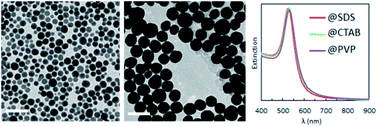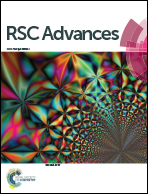One-step green synthesis of gold and silver nanoparticles with ascorbic acid and their versatile surface post-functionalization†
Abstract
In this study, we present a rapid and efficient synthesis of metallic gold and silver nanoparticles using ascorbic acid (vitamin C), which acts both as reducing and stabilizing agent. The size of the particles obtained, in the range of 8 to 80 nm for gold and 20 to 175 nm for silver, and their polydispersity (10–50%) are subtly affected, therefore tunable, by the pH of either the metal salt solution or the ascorbic acid solution. We also show that one of the main features of this synthetic approach is the simple, fast and versatile nanoparticle surface modification with a large variety of water soluble surfactants that can be neutral, positively or negatively charged.


 Please wait while we load your content...
Please wait while we load your content...